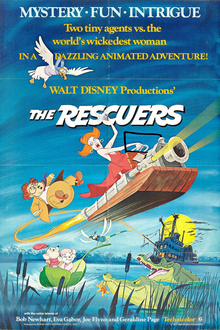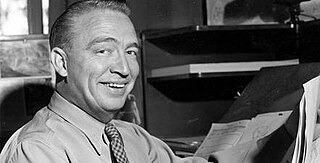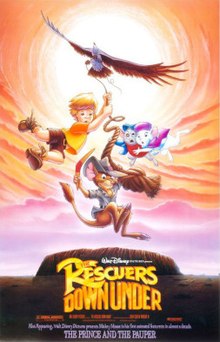
Goofy is an American cartoon character created by the Walt Disney Company. He is a tall, anthropomorphic dog who typically wears a turtle neck and vest, with pants, shoes, white gloves, and a tall hat originally designed as a rumpled fedora. Goofy is a close friend of Mickey Mouse and Donald Duck, and is Max Goof's father. He is normally characterized as hopelessly clumsy and dim-witted, yet this interpretation is not always definitive; occasionally, Goofy is shown as intuitive and clever, albeit in his own unique, eccentric way.

The golden age of American animation was a period in the history of U.S. animation that began with the popularization of sound synchronized cartoons in 1928 and gradually ended in the 1960s when theatrical animated shorts started to lose popularity to the newer medium of television. Animated media from after the golden age, especially on television, were produced on cheaper budgets and with more limited techniques between the 1960s and 1980s.
Modern animation in the United States from the late 1980s to the early 2000s is frequently referred to as the renaissance age of American animation. During this period, many large American entertainment companies reformed and reinvigorated their animation departments, following the dark age, and the United States had an overall profound effect on animation globally.

The Rescuers is a 1977 American animated adventure comedy-drama film produced by Walt Disney Productions and released by Buena Vista Distribution. Bob Newhart and Eva Gabor respectively star as Bernard and Bianca, two mice who are members of the Rescue Aid Society, an international mouse organization dedicated to helping abduction victims around the world. Both must free young orphan Penny from two treasure hunters, who intend to use her to help them obtain a giant diamond. The film is based on a series of books by Margery Sharp, including The Rescuers (1959) and Miss Bianca (1962).

The Great Mouse Detective is a 1986 American animated mystery adventure film produced by Walt Disney Feature Animation and released by Walt Disney Pictures. It is based on the children's book series Basil of Baker Street by Eve Titus and Paul Galdone, and was written and directed by John Musker, Dave Michener, Ron Clements, and Burny Mattinson in their feature directorial debuts. Featuring the voices of Vincent Price, Barrie Ingham, Val Bettin, Susanne Pollatschek, Candy Candido, Diana Chesney, Eve Brenner, and Alan Young, the film's plot follows Basil of Baker Street, a mouse detective who undertakes to help the young mouse Olivia find and save her father from the criminal mastermind and Basil's sworn enemy, Professor Ratigan.

Walt Disney Animation Studios (WDAS), sometimes shortened to Disney Animation, is an American animation studio that creates animated features and short films for The Walt Disney Company. The studio's current production logo features a scene from its first synchronized sound cartoon, Steamboat Willie (1928). Founded on October 16, 1923, by brothers Walt Disney and Roy O. Disney, it is the oldest-running animation studio in the world. It is currently organized as a division of Walt Disney Studios and is headquartered at the Roy E. Disney Animation Building at the Walt Disney Studios lot in Burbank, California. Since its foundation, the studio has produced 62 feature films, from Snow White and the Seven Dwarfs (1937) to Wish (2023), and hundreds of short films.

Eric Cleon Larson was an American animator for the Walt Disney Studios starting in 1933, and was one of "Disney's Nine Old Men".

Wolfgang Reitherman, also known and sometimes credited as Woolie Reitherman, was a German–American animator, director and producer and one of the "Nine Old Men" of core animators at Walt Disney Productions. He emerged as a key figure at Disney during the 1960s and 1970s, a transitionary period which saw the death of Walt Disney in 1966, with him serving as director and/or producer on eight consecutive Disney animated feature films from One Hundred and One Dalmatians through The Fox and the Hound.

Meet the Robinsons is a 2007 American animated science-fiction comedy film produced by Walt Disney Animation Studios and released by Walt Disney Pictures. It is loosely based on the 1990 children's book A Day with Wilbur Robinson by William Joyce. The film was directed by Stephen J. Anderson and produced by Dorothy McKim, from a screenplay that Anderson co-wrote with Don Hall, Nathan Greno, Joe Mateo, Jon Bernstein, Michelle Spitz, and Aurian Redson. The film stars the voices of Daniel Hansen and Jordan Fry, Wesley Singerman, Angela Bassett, Tom Selleck, Harland Williams, Laurie Metcalf, Nicole Sullivan, Adam West, Ethan Sandler, Tom Kenny, and Anderson. It follows an orphaned 12-year-old inventor, Lewis, who is desperate to be adopted. He meets Wilbur Robinson, a young time-traveler who takes him to the year 2037 to visit his eccentric family. They must prevent a mysterious bowler-hatted man from changing Lewis' fate, and, by proxy, the future.

Disney Television Animation (DTVA) is an American animation studio that serves as the television animation production arm of Disney Branded Television, a division of Disney General Entertainment Content, which is a division of Disney Entertainment. The studio was originally established in 1984, by Gary Krisel during the reorganization and subsequent re-incorporation of Disney following the arrival of then CEO Michael Eisner that year.

Joseph Henry Ranft was an American animator, screenwriter, and voice actor. He worked for Pixar Animation Studios and Disney at Walt Disney Animation Studios and Disney Television Animation. His younger brother Jerome Ranft is a sculptor who also worked on several Pixar films.

Randy Cartwright is an American animator.
Rubén Procopio is an American animation and comic book artist, animator and sculptor. Long affiliated with Walt Disney Feature Animation as an animator and sculptor, Rubén is credited with restoring the maquette process to feature animation film production in the early 1980s. He is the founder of Masked Avenger Studios, whose clients include Walt Disney Studios, Warner Bros. Studios, New Line Cinema, Cartoon Network, Electric Tiki and DC Comics. He is known for his versatile sculpting and illustration style in both cartoony and realistic characters, with an emphasis on Disney characters, superheroes, and the masked heroes of yesteryear.
Kirk Wise is an American film director, animator and screenwriter best known for his work at Walt Disney Animation Studios. Wise has directed Disney animated films such as Beauty and the Beast, The Hunchback of Notre Dame, and Atlantis: The Lost Empire. He also directed the English-language translation of Hayao Miyazaki's Spirited Away. He frequently works with Gary Trousdale and Don Hahn.

Nik Ranieri is a character animator who is primarily known for his work at Walt Disney Animation Studios. He has been supervising animator of many characters and remained so until his layoff in 2013.

The Disney Renaissance was a period from 1989 to 1999 during which Walt Disney Feature Animation returned to producing critically and commercially successful animated films. These were mostly musical adaptations of well-known stories, similar to the films produced during the era of Walt Disney from the 1930s to 1960s. The resurgence allowed Disney's animated films to become a powerhouse of successes at the domestic and foreign box office, earning much greater profits than most of the Disney films of previous eras.
Mark Alan Henn is an American animator and film director. His work includes animated characters for Walt Disney Animation Studios films, most notably leading or titular characters and heroines. He served as the lead animator for Ariel in The Little Mermaid, Belle in Beauty and the Beast, Jasmine in Aladdin, Young Simba in The Lion King, the title character in Mulan and Tiana in The Princess and the Frog. He directed the short film John Henry. Henn spent a total of 43 years at Walt Disney Animation Studios, from 1980 until his retirement in 2023.

Waking Sleeping Beauty is a 2009 American documentary film directed by Disney film producer Don Hahn and produced by Hahn and former Disney executive Peter Schneider. The film documents the history of Walt Disney Feature Animation from 1984 to 1994, covering the rise of a period referred to as the Disney Renaissance.














